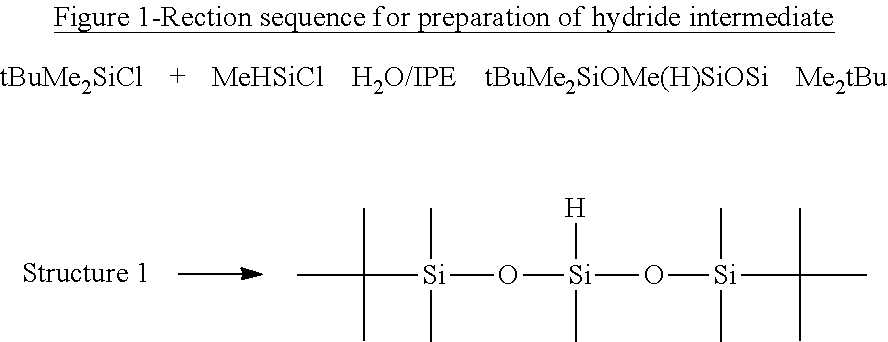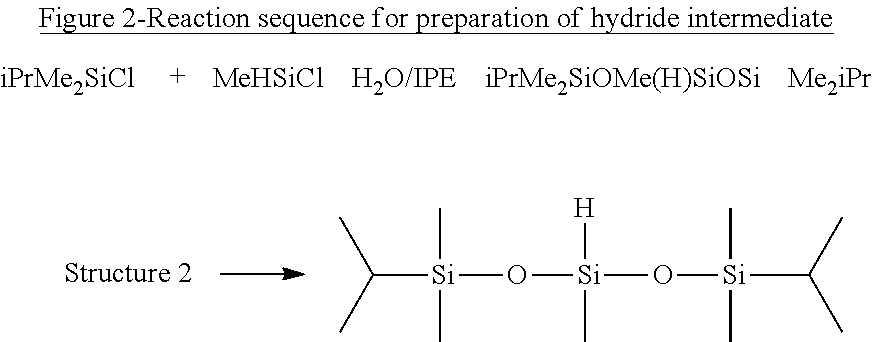Hydrolysis Resistant Organomodified Trisiloxane Surfactants
a trisiloxane surfactant, organomodified technology, applied in the direction of rodenticides, biocides, herbicides and algicides, etc., can solve the problem that the trisiloxane compound is not stable to hydrolysis and undergoes a rapid decomposition
- Summary
- Abstract
- Description
- Claims
- Application Information
AI Technical Summary
Problems solved by technology
Method used
Image
Examples
preparation example 1
[0092]1,5-di(t-butyl)-1,1,3,5,5, Pentamethyltrisiloxane (FIG. 1, Structure 1).
[0093]100 g tBuMe2SiCl and 46 g MeHSiCl2 were dissolved in 150 ml isopropylether (IPE) and placed in an addition funnel. 150 g water and 250 ml IPE were charged into a 1 L round bottom flask equipped with a mechanical stirrer, reflux condenser and N2 inlet. The chlorosilanes were added dropwise via the addition funnel at room temperature (23° C.) over a period of 1 h. After addition was completed, the temperature was adjusted to 70° C. and the reaction was run at reflux temperature for 20 h and progress followed by GC (88% yield at 20 h). When the reaction was finished, the water was drained off via a separation funnel. The fluid was washed 3 times using 100 g of water each time. 25 g of NaHCO3 was mixed with 100 g of water and added slowly to the mixture and stirred for 30 min. The water was again drained and dried over sodium sulfate. After filtering, the IPE was stripped off on the rotor evaporator and ...
preparation example 2
[0094]1,5-di(isopropyl)-1,1,3,5,5, Pentamethyltrisiloxane (FIG. 2, Structure 2).
[0095]25 g iPrMe2SiCl (0.183 moles) and 13.1 g MeHSiCl2 (0.114 moles) were dissolved in 80 ml isopropylether (IPE) and placed in an addition funnel. 50 g water and 100 ml IPE were charged into a 500 ml round bottom flask equipped with a mechanical stirrer, reflux condenser and N2 inlet. The chlorosilanes were added dropwise via the addition funnel at room temperature (23° C.) over a period of 40 min. After addition was completed, the temperature was adjusted to 80° C. and the reaction was run at reflux temperature for 4 h and progress followed by GC (75% yield at 4 h). When the reaction was finished, the water was drained off via a separation funnel. The fluid was washed 3 times using 80 g of water each time. 25 g of NaHCO3 was mixed with 100 g of water and added slowly to the mixture and stirred for 30 min. The water was again drained and dried over sodium sulfate. After filtering, the IPE was stripped ...
preparation example 3
[0096]The hydride intermediates of Examples 1-2 were further modified with various allylpolyalkyleneoxides to yield the organomodified trisiloxane surfactant compositions of the present invention (Table 1), as well as the comparative trisiloxane surfactants (From Table 2).
[0097]The organomodified trisiloxane surfactant compositions of the present invention were prepared by conventional methods of platinum mediated hydrosilation, as described in Bailey, U.S. Pat. No. 3,299,112, herein incorporated by reference.
[0098]Table 1 provides a description of the compositions of the present invention. Some of these compositions are described by the structure:
M*D′M*
where M*=R1Si(CH3)2O0.5;
D′=OSi(CH3)CH2CH(R32)CH2O—(CH2CH2O)r—(CH2CH2O)sR33
where R1, R32, R33, subscripts r, and s are described in Table 1.
TABLE 1Description of Organomodified Trisiloxane Surfactant CompositionsI.D.R1R13rsR331(CH3)3C—H011H2(CH3)2CH—H011H3CH3—CH317.5CH3
[0099]Table 2 provides a description of the comparative trisiloxa...
PUM
| Property | Measurement | Unit |
|---|---|---|
| pH | aaaaa | aaaaa |
| composition | aaaaa | aaaaa |
| resistance | aaaaa | aaaaa |
Abstract
Description
Claims
Application Information
 Login to View More
Login to View More - R&D
- Intellectual Property
- Life Sciences
- Materials
- Tech Scout
- Unparalleled Data Quality
- Higher Quality Content
- 60% Fewer Hallucinations
Browse by: Latest US Patents, China's latest patents, Technical Efficacy Thesaurus, Application Domain, Technology Topic, Popular Technical Reports.
© 2025 PatSnap. All rights reserved.Legal|Privacy policy|Modern Slavery Act Transparency Statement|Sitemap|About US| Contact US: help@patsnap.com


